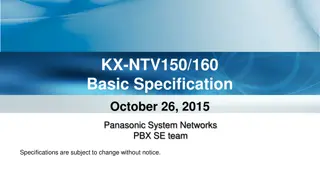
International Product Classification Systems
Explore the significance of international product classification systems such as Statistical Classification of Products by Activity (CPA), Harmonized System (HS), Central Product Classification (CPC), and Combined Nomenclature (CN). Learn how these systems organize products, facilitate statistical data collection, and support international trade. Gain insights into the purpose and usage of CPA and HS codes in the global market.
Download Presentation

Please find below an Image/Link to download the presentation.
The content on the website is provided AS IS for your information and personal use only. It may not be sold, licensed, or shared on other websites without obtaining consent from the author. If you encounter any issues during the download, it is possible that the publisher has removed the file from their server.
You are allowed to download the files provided on this website for personal or commercial use, subject to the condition that they are used lawfully. All files are the property of their respective owners.
The content on the website is provided AS IS for your information and personal use only. It may not be sold, licensed, or shared on other websites without obtaining consent from the author.
E N D
Presentation Transcript
International codes for product: I. Statistical Classification of Products by Activity (CPA) II. Harmonized System (HS) III.Central Product Classification (CPC) IV.Combined Nomenclature (CN)
International Product Codes: Product Classification systems organize products using standardized coding systems. There are several different classification systems that each classify products using alpha-numerical designations. There is not a universal product classification system and therefore the systems used in a particular country will vary.
Statistical Classification of Products by Activity (CPA): The Statistical Classification of Products by Activity (CPA) is the classification of products (goods as well as services) at the level of the European Union (EU). Product classifications are designed to categorize products that have common characteristics. They provide the basis for collecting and calculating statistics on the production, distributive trade, consumption, international trade and transport of such products CPA product categories are related to activities as defined by the Statistical classification of economic activities in the European Community (NACE).
Each CPA product - whether a transportable or non-transportable good or a service - is assigned to one single NACE activity. This linkage to NACE activities gives the CPA a structure parallel to that of NACE at all levels. What are CPA Codes used for? The internal market requires statistical standards applicable to the collection, transmission and publication of national and community statistics. Enables enterprises, financial institutions, governments and all other operators in the internal market can be provided with reliable and comparable statistical data.
Harmonized System (HS): The Harmonized Commodity Description and Coding System (Harmonized System or HS) is a multipurpose international product nomenclature developed by the World Customs Organization (WCO). It comprises about 5,300 commodity groups each identified by a six digit code, arranged in a legal and logical structure and is supported by well-defined rules to achieve uniform classification. The HS is a universal economic language and code for goods, and an essential tool for international trade. The Harmonized System is governed by "The International Convention on the Harmonized Commodity Description and Coding System".
What is HS used for? Used by more than 200 countries and economies as a basis for their Customs tariffs and for the collection of international trade statistics Over 98% of the merchandise in international trade is classified in terms of the HS The HS contributes to the harmonization of Customs and trade procedures It also contributes to the non-documentary trade data interchange in connection with such procedures, thus reducing the costs related to international trade. It is also extensively used by governments, international organizations and the private sector for many other purposes such as:
Internal taxes Trade policies Monitoring of controlled goods Rules of origin Freight tariffs Transport statistics Price monitoring Quota controls Compilation of national accounts Economic research and analysis
Central Product Classification (CPC): The CPC constitutes a comprehensive classification of all products, including goods and services. CPC presents categories for all products that can be the object of domestic or international transactions or that can be entered into stocks. It includes products that are an output of economic activity, including transportable goods and non-transportable goods, products, and services.
Why are CPC Codes used? To provide a basis for recompiling basic statistics from their original classifications into a standard classification for analytical use To enhance harmonization among various fields of economic and related statistics To strengthen the role of national accounts as an instrument for coordination of economic statistics
Combined Nomenclature (CN): CN stands for Combined Nomenclature. It is the common nomenclature of the European Community and is an 8-digit product classification system used in export declarations and in statistical declarations for trade in the European Community. All products and goods exported from the European Union or imported into European Union must be classified for Customs purposed. Every product will be assigned to a particular product classification code. Changes to the nomenclature occur every year and are updated and reflected into the nomenclature at the beginning of the following year. The CN is comprised of the Harmonized System (HS) nomenclature with further Community subdivisions.
What are CN codes used for? Collection and publishing of products and goods statistics for both intra and extra Community Custom tariffs (Article 9 of the Treaty establishing the EEC) determined by the subheading of the nomenclature Laws on agricultural matters Trade negotiations




